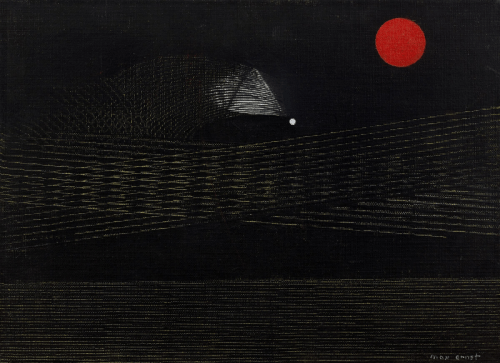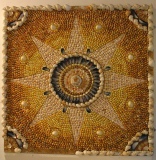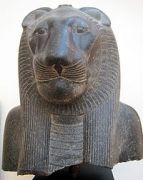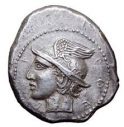“As in the hand a sulfur match flares white
and sends out flicking tongues on every side
before it bursts into flame –: in that ring
of crowded onlookers, hot, eager, and precise
her round dance begins to dart and spread.And all at once it is entirely flame.
With a glance she sets her hair ablaze
and whirls suddenly with daring art
her slender dress into this fiery rapture,
from which, like snakes awakened,
two naked arms uncoil, aroused and rattling.And then: as if she felt the fire grow tight,
she gathers it all up and casts it off
disdainfully, and watches with imperious
command: it lies there raging on the ground
and still flares up and won’t surrender –.
But unwavering, assured, and with a sweet
welcoming smile she lifts her face
and stamps it out with rock-hard little feet.”Reiner Maria Rilke, “Spanish Dancer,” translated by Edward Snow, quoted from “New Poems,” Kindle edition

Hans Rudolf Strupler, Composition in Red
Mysterium Coniunctionis: An Inquiry into the Separation and Synthesis of Psychic Opposites in Alchemy (volume 14 of Collected Works) was completed by Jung when he was 81 and is a synthesis of his lifelong work on marrying alchemy and psychology. A central symbol of alchemy was Mercurius, which was a subject of part 5 of this series. In basic terms, Mercurius can be understood as the unconscious matrix itself, the cosmic Nous (Mind), or the spirit which appears in reality in differentiated form. The active, masculine aspect of Mercurius is Sol, the feminine and passive one – Luna (par. 109 of Mysterium Coniunctionis – all subsequent quotes comes from this book). Mercurius in Jung’s words is “a dark, latent, non-manifest side, the unconscious, whose presence can be known only by the light of consciousness” (par. 109). To manifest itself, Mercurius needs other transformative substances, sol and sulphur being vital in this equation.

Max Ernst, “Red Sun”
The sun is as ambivalent and multi-faceted as any other alchemical symbol. It was perceived as “an active substance hidden in the gold” and extracted as red tincture (par. 109). It was believed to contain an active, hot, dry and red sulphur, which is how the alchemists explained its redness. Sulphur has always been a universal attribute of the devil and infernal fires. As a chemical substance it is sharply penetrating and has an extremely pungent smell. It ignites rapidly and produces a very bright and a very hot flame. When burned, it melts to a blood-red liquid and emits a blue flame. However, chemists know that in fact it is not sulphur that can make gold red, but copper, which for alchemists was associated with Venus. This makes things interesting, since the planet Venus in its appearance as the morning star (Venus Phosphorus – “Light-Bringer) was called “Lucifer” in Latin, a name also given to the most beautiful of fallen angels. In alchemy, all symbols are light and dark in equal measure. Darkness is not the absence of light, but an entity of equal importance and endowed with a tangible substance.

Stanislaw Wyspianski, “Eos, Phosphoros, Hesperos, Helios”
The sun’s favorable effects were its generational and transformative properties, fostering growth of fruit, wine and the mineral gold in the bowels of the earth. In humans, it was said to “enkindle the inner warmth,” will and appetites; as a “vital spirit” it was believed to have “its seat in the brain and its governance in the heart” (par. 110). Alchemists called the sun “the father and begetter of all.” Sulphur was the hot and deamonic principle of life, the vital energy, the “central fire,” in short – the soul (par. 112). What Dylan Thomas called “the force that through the green force drives the flower” in his magnificent classic poem was referred to as “the animating principle” by the alchemists. They believed in the universality and ubiquity of this “universal power of growth, healing, magic and prestige” (par.113). It was present in the sun above and in the plants and humans below. This supreme power was the alchemical gold, which was not the common gold (aurum vulgi), but a miraculous, incorruptible substance, “the true and indubitable treasure” (par. 113), which could only be perceived by those who can see with their mind’s eye.

Paul Klee, “Ad Marginem”
But since every alchemical substance had its shadow, so the sun was equipped with one also. Jung quotes Maier: “For what, in the end is this sun without a shadow? The same as a bell without a clapper” (par. 116). A saying of Hermes, pivotal for all alchemists, deserves to be quoted in its entirety: “Son, extract from the ray its shadow, and the corruption that arises from the mists which gather about it, befoul it and veil its light; for it is consumed by necessity and by its redness.” This admonition can be explicated in the following terms. In the first stage of the alchemical opus, the sun is obscured by the shadow. This is the Black Sun, the earthly sun, which is “an instrument in the physiological and psychological drama of return to the prima materia, the death that must be undergone if man is to get back to the original condition of the simple elements and attain the incorrupt nature of the pre-worldly paradise” (par. 117). The black sun brings about the death of the old. This putrefaction cannot be achieved without sulphur, whose role is to “corrupt man back to his first essence.” In the next stage, the reborn sun will be joined with Mercurius, but before that can happen, the sun is not only obscured by the shadow but it will also be “consumed by necessity and by its redness.” This brings sulphur back onto the stage.

Max Ernst, “Sea and Sun”
Alchemists distinguished between a red and a white sulphur. The former was the active substance of the moon, the latter was believed to be more virtuous and it was said to be the active substance of the sun. Sulphur was chthonic, corporal and earthly; it was associated with the fire breathing dragon. It was Paracelsus who referred to sulphur as the soul, which together with salt (the body) beget Mercurius. The red masculine sulphur is the fiery ferment of the soul’s hidden depths. Gerhard Dorn (quoted here after Jung) called it “the male and universal seed, …, the first part and most potent cause of all generation” (par. 136). It is a generative power that burns and consumes from within. Too much of it corrupts and weakens, bringing about evil and blackness, violence and rampant instincts, but without it there would be no impetus to life and no progress. In a concluding paragraph, Jung calls compulsion symbolized by sulphur “the great mystery of human life,” “the thwarting of our conscious will and of our reason by an inflammable element within us, appearing now as a consuming fire and now as life-giving warmth” (par. 150).

Marc Chagall, “Field of Mars”

Support my blog
If you appreciate my writing, consider donating and make my day. Thank you in advance.
$1.00
Related posts:












I do believe dear Monika that the Sun brings us a lot more than life and light and warmth.. I am sure somehow we are all tied into its mesmerising consciousness So interesting to read upon this subject. I have never really explored in depth Jung..
I smile as this week we both have posts with the Sun.. and I see I need to read about the Mandalas you posted also
Many thanks for your own lovely visit.. It was lovely to have you visit xx❤
LikeLiked by 1 person
It is always so nice to hear from you, Sue. I am not surprised by this synchronicity between us 🙂
Thank you very much for leaving a comment.
Monika
LikeLiked by 1 person
🙂 I am always educated within your posts dear Monika.. You bring a wealth of knowledge within your postings.. 🙂 I always leave understanding a little more than when I arrived 😀
LikeLike
Hi Monika, you may be writing for a very few select readers here, as CW 14 is far from Jung’s easiest book to read and was the summation of his life-long study of alchemy. A caveat warning might avoid disappointment for those attempting to read this late work ! It might also perhaps have been interesting to read why Jung’s alchemical writings are of interest you and how they have assisted your own growth of self-awareness.
The great advocate of Paracelsus, Gerhard Dorn is Jung’s most frequently cited alchemical author. Dorn’s mention of an ‘invisible sun’ in vol. 14 must surely have been the source of Sir Thomas Browne’s great utterance – ‘Life is a pure flame, and we live by an invisible sun within us.’. There are quite a few references in vol.14 to Saturn being the shadow side of the sun. Some really great choices of modern art accompanying your post help understand visually what was the summation of Jung’s study of alchemy.
LikeLiked by 1 person
Hi Kevin,
I never presumed to have more than a few select readers. And I cherish them! About CW 14, I read it first over 10 years ago and am revisiting right now. I think you are absolutely right it is very dense and not recommended for Jung beginners.
That quote from Thomas Browne really hits the mark. Interesting you should mention Saturn. It was a dream about a golden Saturn that had taken place of the eclipsed Sun in the sky that brought me to Jung and alchemy. I felt I had received some kind of revelation that I did not understand, though I very much wanted to. With the risk of sounding arrogant, I cannot say Jung’s writing is difficult for me. On the contrary, it is like finally experiencing something which is very much my own, remembering something long forgotten rather than learning something new. So effortless, actually.
Always happy to read your comments. Thank you.
Monika
LikeLike
Reblogged this on lampmagician.
LikeLike
Beautiful 🙂
LikeLike
Thank you for putting this together.
LikeLiked by 1 person
Thank you for putting this together. It’s one of the best articles on the topic I could find yet. And your choice of imagery is splendid as well.
LikeLiked by 1 person
Thank you – I deeply appreciate it.
LikeLike